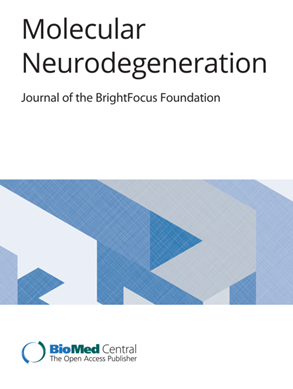Alzheimer’s disease protective allele of Clusterin modulates neuronal excitability through lipid-droplet-mediated neuron-glia communication
IF 17.5
1区 医学
Q1 NEUROSCIENCES
引用次数: 0
Abstract
Genome-wide association studies (GWAS) of Alzheimer’s disease (AD) have identified a plethora of risk loci. However, the disease variants/genes and the underlying mechanisms have not been extensively studied. Bulk ATAC-seq was performed in induced pluripotent stem cells (iPSCs) differentiated various brain cell types to identify allele-specific open chromatin (ASoC) SNPs. CRISPR-Cas9 editing generated isogenic pairs, which were then differentiated into glutamatergic neurons (iGlut). Transcriptomic analysis and functional studies of iGlut co-cultured with mouse astrocytes assessed neuronal excitability and lipid droplet formation. We identified a putative causal SNP of CLU that impacted neuronal chromatin accessibility to transcription-factor(s), with the AD protective allele upregulating neuronal CLU and promoting neuron excitability. And, neuronal CLU facilitated neuron-to-glia lipid transfer and astrocytic lipid droplet formation coupled with reactive oxygen species (ROS) accumulation. These changes caused astrocytes to uptake less glutamate thereby altering neuron excitability. For a strong AD-associated locus near Clusterin (CLU), we connected an AD protective allele to a role of neuronal CLU in promoting neuron excitability through lipid-mediated neuron-glia communication. Our study provides insights into how CLU confers resilience to AD through neuron-glia interactions.聚簇蛋白的阿尔茨海默病保护等位基因通过脂滴介导的神经元-胶质细胞通讯调节神经元兴奋性
阿尔茨海默病(AD)的全基因组关联研究(GWAS)已经确定了大量的风险位点。然而,疾病变异/基因及其潜在机制尚未得到广泛研究。在诱导多能干细胞(iPSCs)分化的各种脑细胞类型中进行大量ATAC-seq,以鉴定等位基因特异性开放染色质(ASoC) snp。CRISPR-Cas9编辑生成等基因对,然后分化为谷氨酸能神经元(iGlut)。iGlut与小鼠星形胶质细胞共培养的转录组学分析和功能研究评估了神经元兴奋性和脂滴形成。我们确定了CLU的一个假定的因果SNP,它影响神经元染色质对转录因子的可及性,AD保护性等位基因上调神经元CLU并促进神经元兴奋性。此外,神经元CLU促进了神经元到胶质细胞的脂质转移和星形胶质细胞脂滴的形成以及活性氧(ROS)的积累。这些变化导致星形胶质细胞摄取较少的谷氨酸,从而改变神经元的兴奋性。对于簇蛋白(CLU)附近的AD相关位点,我们将AD保护等位基因与神经元CLU通过脂质介导的神经元-胶质细胞通讯促进神经元兴奋性的作用联系起来。我们的研究提供了CLU如何通过神经元-神经胶质相互作用赋予AD恢复力的见解。
本文章由计算机程序翻译,如有差异,请以英文原文为准。
求助全文
约1分钟内获得全文
求助全文
来源期刊

Molecular Neurodegeneration
医学-神经科学
CiteScore
23.00
自引率
4.60%
发文量
78
审稿时长
6-12 weeks
期刊介绍:
Molecular Neurodegeneration, an open-access, peer-reviewed journal, comprehensively covers neurodegeneration research at the molecular and cellular levels.
Neurodegenerative diseases, such as Alzheimer's, Parkinson's, Huntington's, and prion diseases, fall under its purview. These disorders, often linked to advanced aging and characterized by varying degrees of dementia, pose a significant public health concern with the growing aging population. Recent strides in understanding the molecular and cellular mechanisms of these neurodegenerative disorders offer valuable insights into their pathogenesis.
 求助内容:
求助内容: 应助结果提醒方式:
应助结果提醒方式:


